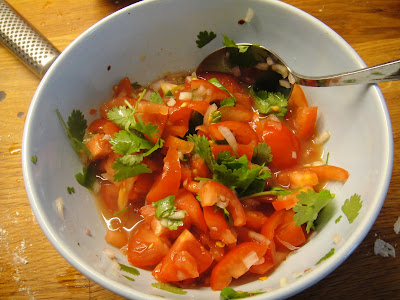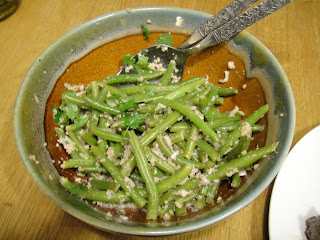In order to celebrate that me and my husband have been together for 15 years we decided to have dinner at Franzén/Lindeberg, one of the top restaurants in Stockholm with two recent stars in the Guide Rouge. They are well known for their experimental approach to cooking and use of fresh local ingredients. There is no set menu, you get served a multicourse one that includes whatever is fresh that very day.
First thing that happens is that the waitress puts a box on out table, containing a loaf of rising dough. A little something to rest our eyes on, to help us get in touch with the meal we are about to experience. A little odd, but I've had worse company while eating out.
The starters are served in a series of 5 where the theme is "raw".
First, an amuse bouche. Two carrot meringues, sandwiched and served macaron style with a foie gras pâté between. The meringues were amazing, perfectly soft and brittle, sweet carrot flavour, no hint of chewiness.
Second, looks like a piece of sushi with raw halibut on top but instead of rice there is this paste containing crab, whitefish roe and chives. A vinaigrette is spooned over the fish, containing canola oil and butter(!).
Third a tartar of langoustine and ruby grapefruit served with a slice of lardo and rosemary and crushed almonds on top. A dollop of apple butter with vanilla on the side.
Fourth, a duck breast is "cooked" in front of us by pointing a blowtorch towards a piece of coal. The flame bounces off the coal onto the duck. I don't think this was a standard dish, there were sparks going in all directions, including into the carpet, making the staff look worried. The duck breast was then thinly sliced and served with duck heart, beetroots, rhubarb and raspberry sauce. Raw, frozen duck liver was grated on top.
Last starter was a chilled, foamy cucumber and horseradish soup. The soup was topped with caviar pearls and ostronört (oysterherb in direct translation). The ostronört gets its name as it tastes of oysters and I can guarantee you, it really does. I've never had anything like it (except for oysters then). I'm dying to get some and start cultivation it on my balcony.
We went for their "wine menu" to go with the food. The starters were served with a rosé from Tavel. Lots of herbs, more like a light red wine than the strawberry and rose flavoured rosé Swedish people gulp down by the bottle, hanging out in parks.
At some point around starter 4 the waitress takes our bread box back to the kitchen, and now the bread comes back out after beeing baked over burning charcoals. I have to say, this might be the best bread I've ever had. Silky soft on the inside with a thin but crackling crust, charry spots all around. With the bread comes a little pouch of home churned butter. A little saltier, a little sweeter and a little more acid that we're used to, this might be the best butter I've ever had.
Next, there is scallop in two servings. First it's served grilled in its own shell, gratineed with a paste of butter and duck egg. Grated brown truffle on top. Second time around our waitress pours a dashi inspired broth, made from mushrooms and algae, into the, by then, empty shell and hands us a small scallop tartar on the side.
A white Rhone (Chapoutier) with the scallop.
Next in line is the "Satio Tempestas". This one is always on the menu and is a kind of house salad. There is a piece of white fish (I unfortunately don't remember which one) and about 30 different leafs, herbs and vegetables, chosen according to the season. All of these are prepared individually in whatever manner seems most suitable. There is parsley made into a pesto, leaves of "plister" au naturelle, a lightly boiled or steamed piece of carrot, leek powder etc etc. On top there is a light sprinkling of deep fried fish scales. This dish made me happy, so fresh and I just love when vegetables are treated with the respect they deserve, letting each one shine!
A powerful white Bourgogne with the chicken.
Then, a palate cleanser. Sorbet of lemon verbena and chamomile. A good combo. The verbena contributing freshness and the chamomile contributing calm herbness. Herbs in sorbets are underrated.
Next, two variations on chicken. First a velouté made with chicken stock and onions, served with a big dollop of cream whipped with liquorice. This was the only dish that I found to be a little bit to much for me. The soup was great in itself but the cream was a too sweet and the liquorice drowned out the great natural chicken flavour. Next serving was lardo wrapped chicken breast, served with charred onions, frothy almond milk, grated lemon zest and a dollop of pâté made with raw chicken livers. This one was great.
Red Bourgogne with the chicken.
Then, the epilogue: a small piece of newly curdled fresh cheese made of cows milk, served with canola oil, sea salt and grated almonds. This one was so small and simple but perfect. On top of fresh pasta it would be heaven.
Then, a threesome of desserts; one sweet, one salty and one sour. The sweet one; a small log on vanilla and rose ice cream, served with baked tomatoes and raspberry jam. The sour one; lemon variations (lemon meringues, plain lemon segments, lemon curd) served under a blanket of buttermilk with vanilla. A play on lemon meringue pie. The salty one; hazelnut praliné sprinkled with sea salt, served with mead and sorbet made from oxidized pears. The mead and pear sorbet were not very pleasant in themselves, but when they came together... a masterpiece!
Some very sweet German wine with the dessert. It managed to taste good, but very different, with all 3, no small feat!
And at last, with the coffee, 3 macarons. A sweet one stuffed with mashed potatoes and parsnips. A salty one stuffed with salted caramel. And a sour one stuffed with rhubarb and violet jam. By now we were so stuffed it wasn't fun any more...
Dining at Franzén/Lindeberg was a lovely experience. People and restaurants that take food seriously make me happy. The only thing that I'm a little bit hmmmm about are the wines. They were all good and everything but the food was the star and the wines felt mostly like support, not getting to shine. French wines are optimized to go with French food, and this was Swedish food. For me, I'd served it with birch sap (seriously) and a big carafe of iced vodka on the side, in order to keep up whatever level of alcohol people are used to when eating in restaurants.
And, if there is something to be learnt, this is it:
- All butters are not created equal.
- Everything gets better when wrapped in lardo.
- Don't be afraid to play around with your dairy products






































